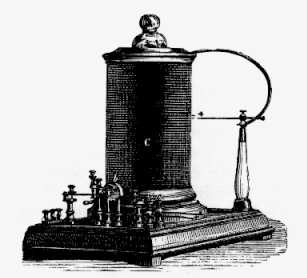Edward Ritchie
Today, let's watch machines shape education -- and invention. The University of Houston's College of Engineering presents this series about the machines that make our civilization run, and the people whose ingenuity created them.
Edward Ritchie, writer Deborah Jean Warner tells us, was "the most innovative American instrument maker ... of the nineteenth century." That sounds exaggerated, but let's look at Ritchie.
He was born in 1814 of well-to-do parents. They let him follow his natural talent for the manual arts and didn't insist on college. By the age of 28 Ritchie was furnishing ships in New Bedford and serving as a church organist. He was 35 when he began making philosophical or mathematical instruments. That meant compasses, telescopes, microscopes, surveying equipment, and the like.
Ritchie wasn't content just to make instruments. He had to invent them as well. In the early days of the Civil War the Navy asked him to copy the English-made liquid compass for ships. After studying the design, he scrapped it. He made and patented a completely new version. He revolutionized ships' compasses.
Just then shipbuilders were turning from wood to iron. Imagine what that did to magnetic fields! Ritchie solved the problem of local magnetic fields by mounting the compass high above the ship's deck and devising means for reading the output below deck. Ritchie was following his instincts, and they were taking him far into the new physics of electricity and magnetism.
Even before the Civil War he'd developed a line of electric induction coils that threw sparks almost a foot. He made those coils as lecture demonstrations. A generation later they would ride in the new automobiles, sending their small lightening bolts across the points of spark plugs to ignite gasoline.
When the great British physicist John Tyndall came to America in 1872 for a lecture tour, Ritchie did his demonstrations. Since education was a driving theme for both Ritchie and Tyndall, they made a good pair. In 1861 Ritchie was one of 37 signers of the charter for a new school in Cambridge, Massachusetts -- The Massachusetts Institute of Technology. Before that, he'd made educational apparatus with Barton Rogers, who went on to become MIT's first president.
One instrument most catches my eye in Ritchie's long inventory -- an elegant demonstration device: you turn a crank and watch the evolution of a traveling wave. Think about swimming out over your head in the ocean. The wave motion around you is subtle. A great wall of water comes at you and you only bob up, then down, while it passes through you. Only with a keen understanding of that complex motion was Schrö able to write his famous wave equation and finally to crack the mysteries of early quantum physics.
When education was fueled by Edward Ritchie's thinking, it drove invention. Ritchie had an instinct for what would be important in our century. And that's why his array of 19th-century explanatory machines so effectively tutored 20th-century thinkers.
I'm John Lienhard, at the University of Houston, where we're interested in the way inventive minds work.
(Theme music)
Warner, D.J., Compasses and Coils: The Instrument Business of Edward S. Ritchie. Rittenhouse, Vol. 9, No. 1, 1994, pp. 1-24.
I am grateful to Helen Coffeen for providing me with issues of Rittenhouse and urging me to do programs from their pages.

Ritchie's Improved Ruhmkorff Spark Coil
from Ritchie's Illustrated Catalogue of Philosophical Instruments and School Apparatus, 1860